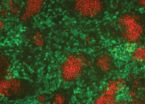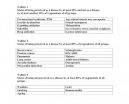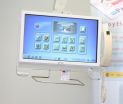(Press-News.org) Instituting and enforcing rules that limit aggressive acts like bodychecking in ice hockey should help reduce injuries for young players, including serious brain and spine injuries, according to a new study published in CMAJ (Canadian Medical Association Journal).
"We found that interventions based on rule changes showed the greatest likelihood of making ice hockey safer for youth," writes Dr. Michael Cusimano, Division of Neurosurgery and the Injury Prevention Research Office, St. Michael's Hospital and the University of Toronto, Toronto, Ontario, with coauthors.
Brain and spinal cord injuries among hockey players have been increasing over the past 15 years and are often the result of aggressive bodychecking. In players aged 9 years, brain injuries account for 15% of all injuries.
"Hostile aggressive acts…were the primary cause of injury in one-third of games in which an injury resulted. Among high school students in Minnesota who played varsity ice hockey, those who played to relieve aggression were 4 times more likely than other players to experience a concussion," write the authors. "These findings highlight the association between aggressive behaviour and injury in ice hockey."
For the CMAJ study, researchers looked at 18 articles that studied interventions aimed at reducing aggressive behaviour in ice hockey. The majority of studies (13) included minor hockey players under age 18. Thirteen studies were conducted in Canada, 4 in the United States and 1 in both countries. Nine studies examined the effectiveness of bodychecking rules and saw fewer penalties, injuries or both, with a decrease of 1.2.9 penalties per game and a 3 fold reduction in injuries. Several studies looking at fair-play programs, educational programs and behavioural modification to reduce injuries indicated fewer penalties. However, the research is inconclusive on whether these types of interventions reduce injury rates.
"Rule changes essentially alter the culture of a sport and clearly define acceptable behaviour for all stakeholders (players, coaches, parents and officials) simultaneously," state the authors.
"A change toward different rules and their strict enforcement combined with universal education, structural changes in hockey governance, financial and other incentives for safe play and disincentives for unsafe play holds promise for curbing aggression-related injury."
"Strategies that combine such approaches hold promise and should be the topic of future research."
### END
Rules limiting aggression should reduce hockey injuries
2012-12-03
ELSE PRESS RELEASES FROM THIS DATE:
Risk of blood clots 2-fold for women with polycystic ovary syndrome on combined pill
2012-12-03
Women with polycystic ovary syndrome (PCOS) who are taking combined oral contraceptives have a 2-fold risk of blood clots compared with women without the disorder who take contraceptives, states a study published in CMAJ (Canadian Medical Association Journal).
PCOS affects between 6% and 10% of women of reproductive age with some estimates as high as 15%, making it the most common endocrine disorder in this age group. Risk factors for heart disease such as hypertension, diabetes, obesity and others are double among women with PCOS compared with women without the disorder. ...
Clinical trial hits new target in war on breast cancer
2012-12-03
Breast cancers are defined by their drivers – estrogen and progesterone receptors (ER and PR) and HER2 are the most common, and there are drugs targeting each. When breast cancer has an unknown driver, it also has fewer treatment options – this aggressive form of breast cancer without ER, PR or HER2, which was thought not to be driven by hormones, is known as triple negative. A decade ago, work at the University of Colorado Cancer Center added another potential driver to the list – the androgen receptor – and this week marks a major milestone in a clinical trial targeting ...
'Junk DNA' drives embryonic development
2012-12-03
LA JOLLA, Calif., December 3, 2012 – An embryo is an amazing thing. From just one initial cell, an entire living, breathing body emerges, full of working cells and organs. It comes as no surprise that embryonic development is a very carefully orchestrated process—everything has to fall into the right place at the right time. Developmental and cell biologists study this very thing, unraveling the molecular cues that determine how we become human.
"One of the first, and arguably most important, steps in development is the allocation of cells into three germ layers—ectoderm, ...
Grief is not a disease, but cancer is -- what about erectile dysfunction?
2012-12-03
"Understanding peoples' attitudes about whether states of being should be considered diseases can inform social discourse regarding a number of contentious social and health public policy issues," says Kari Tikkinen, MD, PhD, corresponding author of the FIND Survey.
All Finns think that myocardial infarction, breast cancer, malaria and pneumonia are diseases. People are equally unanimous that wrinkles, grief and homosexuality are not diseases. What about drug addiction or absence of sexual desire? Or erectile dysfunction, infertility or obesity?
"The word disease ...
Researchers confirm the 'Pinocchio Effect': When you lie, your nose temperature raises
2012-12-03
The University of Granada researchers are pioneers in the application of thermography to the field Psychology. Thermography is a technique based on determining body temperature.
When a person lies they suffer a "Pinocchio effect", which is an increase in the temperature around the nose and in the orbital muscle in the inner corner of the eye. In addition, when we perform a considerable mental effort our face temperature drops and when we have an anxiety attack our face temperature raises. These are some of the conclusions drawn in this pioneer study conducted at the University ...
BGI's ICG-7 and Bio-IT APAC provides updates on the latest genomics research to advance life science
2012-12-03
December 3, 2012, Hong Kong and Shenzhen, China – The 7th International Conference on Genomics and Bio-IT APAC 2012, organized by BGI, the world's largest genomics organization, successfully concluded with numerous updates on on-going research applying today's latest sequencing and bioinformatics technologies to a new paradigm of human diseases and to enhancing global agriculture development. The three-day conference, held in Hong Kong, also brought new insights into Bio-cloud and big data management. More than 300 participants attended this top-grade international conference.
The ...
Heart-warming memories: Nostalgia can make you feel warmer
2012-12-03
As the nights draw in and the temperature begins to drop, many of us will be thinking of ways to warm up on the dark winter nights. However, few would think that remembering days gone by would be an effective way of keeping warm.
But research from the University of Southampton has shown that feeling nostalgic can make us feel warmer.
The study, published in the journal Emotion, investigated the effects of nostalgic feelings on reaction to cold and the perception of warmth. The volunteers, from universities in China and the Netherlands, took part in one of five studies. ...
Genes link growth in the womb with adult metabolism and disease
2012-12-03
Researchers have identified four new genetic regions that influence birth weight, providing further evidence that genes as well as maternal nutrition are important for growth in the womb. Three of the regions are also linked to adult metabolism, helping to explain why smaller babies have higher rates of chronic diseases later in life.
It has been known for some time that babies born with a lower birth weight are at higher risk of chronic diseases such as type 2 diabetes and cardiovascular disease. Three genetic regions have already been identified that influence birth ...
An innovation will attach patients' electronic medical record to the foot of their hospital bed
2012-12-03
This press release is available in Spanish.
Information and Communication Technologies (ICT) present tremendous potential in the field of healthcare, according to the researchers. "ICTs are going to contribute to a change in focus in aid and health services," comments Jesús Espinosa, CEO of IonIDE Telematics. According to accreditation and standardization associations, Spain is a leader in the management of clinical processes, because it has the greatest number of hospitals that have adopted electronic medical record (EMR). This computerized registry of patients' social, ...
Corn: Many active genes - high yield
2012-12-03
Hybrid plants provide much higher yield than their homozygous parents. Plant breeders have known this for more than 100 years and used this effect called heterosis for richer harvests. Until now, science has puzzled over the molecular processes underlying this phenomenon. Researchers at the University of Bonn and partners from Tübingen and the USA have now decoded one possible mechanism in corn roots. More genes are active in hybrid plants than in their homozygous parents. This might increase growth and yield of the corn plants. The results are published in the renowned ...




